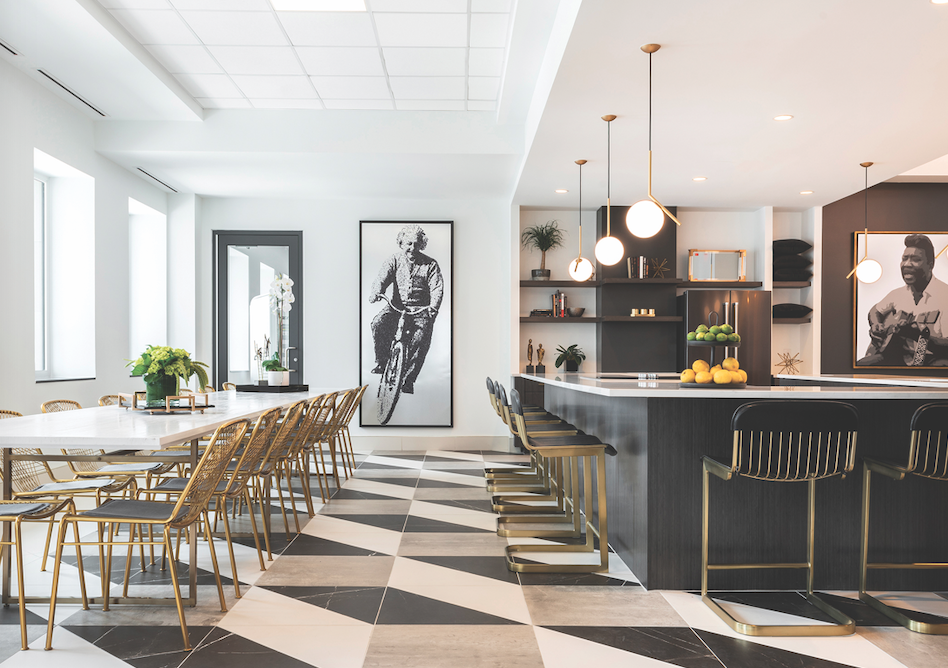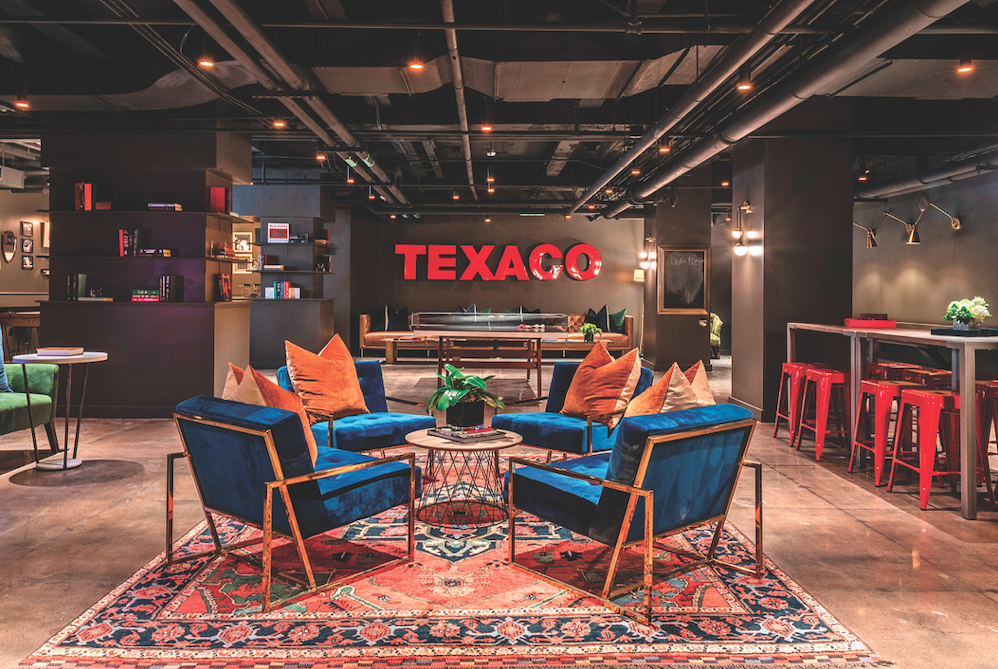After sitting vacant for nearly three decades, the former home of Texaco, Inc. has been converted into a 17-story, 286-unit apartment building in the heart of downtown Houston.
Dallas-based Provident Realty Advisors, which led the $99.5 million enterprise, renamed the property “The Star” as a tribute to the oil giant’s logo—“the big bright Texaco star!” in the old advertising jingle. The redevelopment came on the heels of several unsuccessful attempts to turn the building into a hotel in the years following Texaco’s relocation to the Houston suburbs in 1989.
“It was a beautiful but derelict building right in the center of the new downtown core, surrounded by new office developments, shopping, entertainment, and nightlife,” said Kip Platt, Director of Development and Acquisitions at Provident Realty Advisors.
The Renaissance Revival–style building features a brick, terracotta, and limestone façade, with signature vaulted arcades at street level that promote pedestrian activity. The original 13-story building, completed in 1915, was designed by Warren and Wetmore, a New York architecture firm whose portfolio includes Manhattan’s Grand Central Terminal. A 1938 annex expansion and a 16-story addition, completed in 1958, bulked up the structure to fill a city block. In 2003, the building was placed on the National Register of Historic Places.
The redevelopment team worked closely with the National Park Service and the Texas Historical Commission to qualify for federal and state historic tax credits. The Star was also the first project to benefit from Houston’s new Downtown Living Initiative, which awards $15,000/unit in tax incentives to developers who create new residential projects in the urban core.
 At one time a “ beautiful but derelict building,” according to developer Kip Platt, Provident Realty Advisors, The Star now provides 286 luxury apartments in downtown Houston. The original 17-story structure, completed in 1915, was placed on the National Register of Historic Places in 2003. Photo: Peter Molick
At one time a “ beautiful but derelict building,” according to developer Kip Platt, Provident Realty Advisors, The Star now provides 286 luxury apartments in downtown Houston. The original 17-story structure, completed in 1915, was placed on the National Register of Historic Places in 2003. Photo: Peter Molick
“Most of the structural elements were in really good shape. The building just needed some thorough cleaning, repair, and restoration,” said Robert Jurbergs, AIA, LEED GA, Principal at HBG Design, the Memphis-based architecture firm that oversaw the redesign.
HBG followed strict historic preservation requirements in restoring the structure’s distinctive features, notably its limestone columns, mosaic tiles, decorative chandeliers, bronze grilles, and historic clock. To improve thermal performance, the project team added exterior envelope insulation and specified new energy-efficient windows. “We went back to the original blueprints to ensure the new window profiles were as true to the original wood detailing as possible,” said Jurbergs.
The most pressing problem was how to fit a high-efficiency mechanical system with an additional layer of plumbing, fire protection lines, and mechanical ducts for apartments into a century-old office building.
According to Mark Weaver, FAIA, Principal at HBG Design, the project team circumvented this obstacle by building a 66,000-sf extension on the back side of the original L-shaped building, where historic preservation restrictions were less stringent. This gave them five more high-ceiling apartments with balconies on each floor. They also carved out a cozy outdoor courtyard for a heated, resort-style swimming pool.
The project team squeezed in a nine-level, 750-space parking garage for use by both residents and the general public. The Star sits on the city’s light rail system and ties into the Houston tunnel system, a network of subterranean pedways that links 95 city blocks.
STEPPING BACK INTO HISTORY
The Star’s interior spaces blend contemporary styling with intentional nods to its origins. Large-scale historical photos of the original structure are prominently displayed in the majestic ground-floor lobby. The original Texaco brass elevators have been emboldened with a black geometric design that runs throughout the building.
“It made sense to highlight this amazing, architecturally significant building rather than trying to hide it or make people think it was a new building,” said Lauren Parsons, a design and branding consultant who led the interior design of the amenity spaces. “I wanted it to have a timeless look.”
 Photos of Albert Einstein, Muddy Waters, and others linked to the year 1915 embellish the 17th-floor amenities space, which has a lounge, display kitchen, and Equinox-inspired fitness center. Photo: Lauren Parsons
Photos of Albert Einstein, Muddy Waters, and others linked to the year 1915 embellish the 17th-floor amenities space, which has a lounge, display kitchen, and Equinox-inspired fitness center. Photo: Lauren Parsons
Parsons lived in the building as it was being completed. She curated an eclectic mix of Texaco memorabilia from former employees and collectors for display in the expansive basement game room and lounge area, a dimly lit space that takes its cue from Prohibition-era speakeasies.
The property has 207 one-bedroom and 79 two-bedroom units, with 22 different floor plans ranging from 730 to 1,730 sf, on levels two through 16. Apartments have 11-foot ceilings, quartz countertops, custom cabinetry, stainless steel appliances, and oversized soaking tubs. Monthly rents range from $1,750 to $3,860.
A 1915 design motif extends to the building’s 17th-floor penthouse level, which showcases large-scale black-and-white portraits of Billie Holiday and other cultural figures loosely linked to the year the original building was completed.
AN INTERESTING MIX OF TENANTS
The location can’t be beat. The property is adjacent to the city’s shopping and historic districts and located within 160 feet of 8,000 jobs. The Star is about 90% leased, according to Provident Realty Advisors’ Platt.
“It’s an eclectic group of people who live in the building—from professional basketball players, to artists, to attorneys,” he said. “Anybody can go live in a shiny glass high-rise, but you can’t duplicate the look or character of a historic building. There’s just a unique vibe to it.”
On the project team
DEVELOPER: Provident Realty Advisors ARCHITECT HBG Design INTERIOR DESIGNER Lauren Parsons MECHANICAL/PLUMBING ENGINEER Haltom Engineering ELECTRICAL ENGINEER DePouw Engineering ELEVATOR CONSULTANT Lerch Bates Company GC Provident Realty Advisors Construction
Related Stories
| Jun 17, 2013
DOE launches database on energy performance of 60,000 buildings
The Energy Department today launched a new Buildings Performance Database, the largest free, publicly available database of residential and commercial building energy performance information.
| Jun 13, 2013
AIA partners with industry groups to launch $30,000 'Designing Recovery' design competition
The program will award a total of $30,000 to three winning designs, divided equally between three locations: Joplin, Mo., New Orleans, and New York.
| Jun 12, 2013
5 building projects that put the 'team' in teamwork
The winners of the 2013 Building Team Awards show that great buildings cannot be built without the successful collaboration of the Building Team.
| Jun 11, 2013
Vertical urban campus fills a tall order [2013 Building Team Award winner]
Roosevelt University builds a 32-story tower to satisfy students’ needs for housing, instruction, and recreation.
| Jun 11, 2013
Finnish elevator technology could facilitate supertall building design
KONE Corporation has announced a new elevator technology that could make it possible for supertall buildings to reach new heights by eliminating several problems of existing elevator technology. The firm's new UltraRope hoisting system uses a rope with a carbon-fiber core and high-friction coating, rather than conventional steel rope.
| Jun 5, 2013
USGBC: Free LEED certification for projects in new markets
In an effort to accelerate sustainable development around the world, the U.S. Green Building Council is offering free LEED certification to the first projects to certify in the 112 countries where LEED has yet to take root.
| Jun 4, 2013
SOM research project examines viability of timber-framed skyscraper
In a report released today, Skidmore, Owings & Merrill discussed the results of the Timber Tower Research Project: an examination of whether a viable 400-ft, 42-story building could be created with timber framing. The structural type could reduce the carbon footprint of tall buildings by up to 75%.
| Jun 3, 2013
6 residential projects named 'best in housing design' by AIA
The Via Verde mixed-use development in Bronx, N.Y., and a student housing complex in Seattle are among the winners of AIA's 2013 Housing Awards.
| Jun 3, 2013
Construction spending inches upward in April
The U.S. Census Bureau of the Department of Commerce announced today that construction spending during April 2013 was estimated at a seasonally adjusted annual rate of $860.8 billion, 0.4 percent above the revised March estimate of $857.7 billion.
| May 30, 2013
The Make It Right squabble: ‘How many trees did you plant today?’
A debate has been raging in the blogosphere over the last few months about an article in The New Republic, “If You Build It, They Might Not Come,” in which staff writer Lydia DePillis took Brad Pitt’s Make It Right Foundation to task for botching its effort to revitalize the Lower Ninth Ward of New Orleans.

















